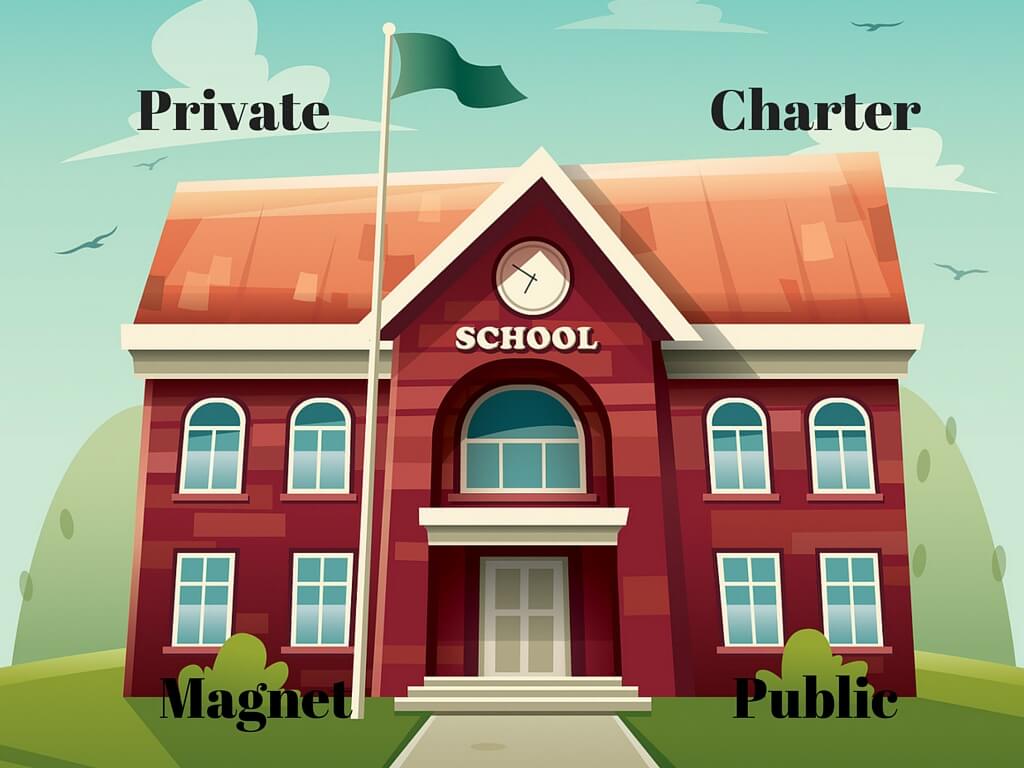If you have children, you have probably wondered about types of schools. How do you know what school is best for your child? What are the differences? Let’s look at the four main types of schools you see around your neighborhood today: public, private, magnet, and charter. Now that you know the names, let’s decipher the differences. First, a defining of what public school is:
Public School
Being the one most people are familiar with, public school is the mainstay. Public schools are funded by the government, which means the government regulates standards, testing, rules/values, and how much money the school will get. “Funded by the government” means your tax dollars, and that also means that location can make a difference regarding the amount of funding going to the school. Politics can make a huge impact on public schools as well. “Funded by the government” also means free, which means it’s easy on the wallet. It also means that some schools are overcrowded, and education can suffer as a result. Public school enrollment is determined by your address. Your residence determines which school you will attend.
Public v. Charter
A charter school is still a public school, but it is an independent public school (read: still gets public funding). Charter schools have been approved to operate the school based on a charter approved by the government. This school charter allows the school to focus on certain programs, and ignore other programs and regulatory guidance. Unlike public schools, charter schools are also allowed to enroll students from across the district (not just students living close to the school).
According to UncommonSchools.org, the exchange for being an independent school is higher standards for performance. Because charter schools spend less time on government regulations, they are capable of running a public school with higher standards. This enables the charter school to accomplish the higher standards in alternative ways. Even though they do have some regulatory freedom, they are still accountable, and can be shut down if they don’t meet the standards set. In fact, some charter schools score on the bottom of Houston’s school rankings.
Public v. Magnet
Magnet schools are another type of public school. While still a public school, a magnet school has a particular academic focus. It may have a focus on fine arts, performing arts, foreign language, STEM (Science, Technology, Engineering and Math), or career focus. Like charter schools, magnet schools may not have all the programs offered at typical public schools.
In order to get into a magnet school, you must often enter a lottery or take an entrance exam. Similar to charter schools, Magnet schools are allowed to enroll students from across the district or even outside the district.
Public v. Private
Private schools are the type of school not funded by the government, but by tuition and fundraisers. In some states, vouchers for education can count towards private schools, but most states, Texas included, do not have a voucher system in place at this time.
While public schools are required to take all children, private schools, also called independent schools, typically have an application process and are not required to accept everyone. Because private schools can turn away students, they tend to have higher performing students.
Another difference between public and private schools is requirement of teacher certification. Public schools are guided by state regulations. Private schools are independent, and typically follow the guidelines of an accrediting agency. Public school teachers are state certified while private school teachers may or may not be (depending on accrediting agency requirements). Private schools are allowed to choose their curriculum and how it is taught. Private schools can also espouse and promote a culture and value system based on the faith and belief of the school and its families.
Because a private school is not government funded, there is a greater freedom in choice of curriculum, teacher ratio, and how teaching occurs. At the Tenney School, for instance, the student-teacher ratio is 1 to 1, compared with up to 30 to 1 in some public schools. Generally, a smaller student-teacher ratio is equated to greater success. This is backed by studies.
Shown by these studies is the following:
- Smaller class sizes raise student grades.
- The more grades your student is in a smaller class size (for instance, K-3 rather than just K), the better the effect on grades.
- Reducing class size alone won’t cut it: the teachers need to be prepared and there need to be enough classrooms.
Public schools are often not equipped to handle smaller class size the way a private school can be if in fact the school is designed to have smaller classes from the ground up.
If you are interested in learning more about how the Tenney School could benefit your student, contact us. We will be glad to talk to you about the different schooling options available to you and which would be the best fit for your child.


